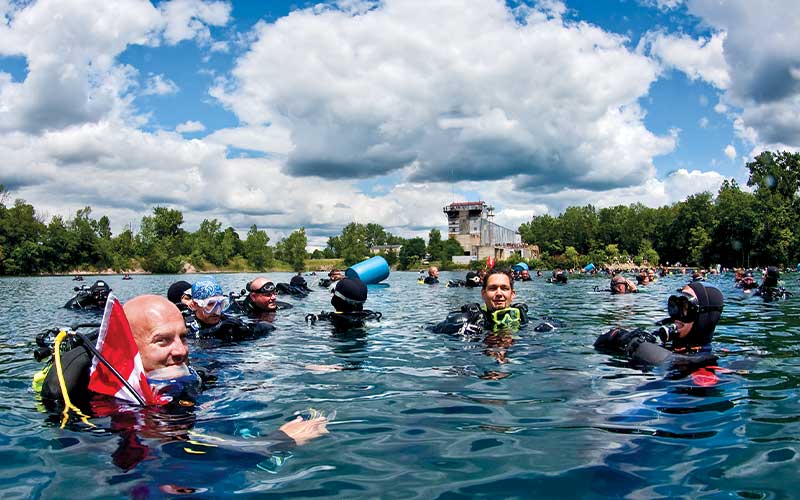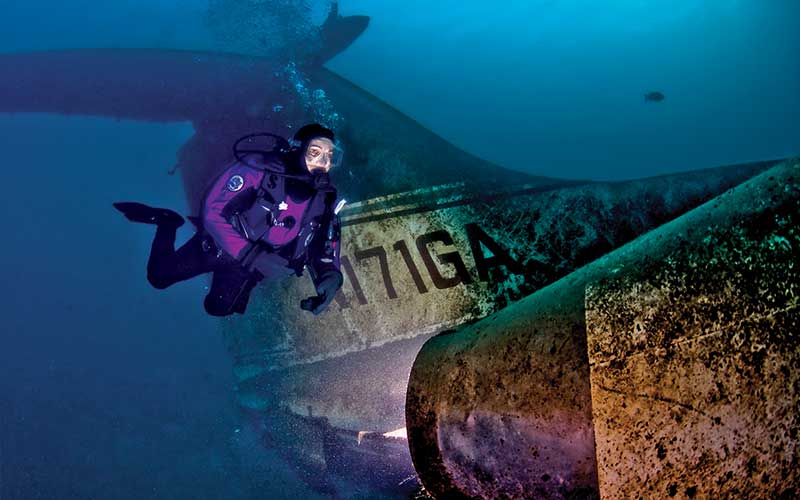I love splashing into the colorful Caribbean Sea or diving with the big animals of the Pacific Ocean. No surprise there. But slipping into the cold waters of northwest Ohio’s quarries to hover above a scuttled cabin cruiser or peer through a sunken airplane likewise reveals a special wonder, and for me it is much, much closer to home.
Nestled within expanses of open land and farm fields, away from the lengths of Great Lakes shorelines lies a triplet of destinations for divers, all within a short drive from each other and in places where you may least expect to find great dive sites: Gilboa Quarry, White Star Quarry and Portage Quarry.
“They are unknown gems,” said Rich Spalding, president of the Ohio-based Toledo Submariners, believed to be one of the oldest dive clubs in the country. Thousands flock to the three northwest Ohio quarries every year to practice skills and explore the unique attractions sunk specifically to entertain divers, including buses, cars, phone booths and even toilets. Admittedly, there are few bright colors, and usually the water is cold, with temperatures varying anywhere between the mid-40s and low-70s. But each is reminiscent of what a diver might encounter in the Great Lakes and, as a result, have become a wreck divers’ practice arena and playground. Many use the quarries as a way to hone cold-water skills.
“[The quarries] have the cold water, and they have the depth. They are just great training sites for those of us who like to do Great Lakes diving,” said Jim Blay, an advanced nitrox decompression diver from New Palestine, Ind. “They’re places to keep our skills keen, to shake off our rust in the spring.”
Each quarry also offers divers services such as concessions, rental equipment and, most important, air fills — both regular and nitrox. For a fraction of the cost of booking a charter boat, divers have the opportunity to enjoy guaranteed easy access and the chance to do what we like best: get wet.

Gilboa Quarry
“There are lots of quarries out there, but it’s the quality of the quarry that keeps people coming back,” said Mike Williams, caretaker at Gilboa Quarry. “It’s the water, the depth, the wildlife, the accessibility. It allows you to dive at a whole other level but still in a controlled environment.”
Gilboa Quarry is located just west of Findlay, Ohio, and claims the title of “deepest” among the quarry trio. Its maximum depth is 137 feet, although divers can certainly choose to spend their bottom time at shallower depths. Those who dive the deep side must be certified or accompanied by an instructor, and all are required to complete a dive plan in advance.

The walk to the shallow side and its platforms can be tiring, but it’s well worth the effort. With options of a giant stride or a gentle entry down the steps, divers almost immediately encounter a 68-foot jet, a bladeless helicopter and, a personal favorite, a yellow school bus.
Perhaps the most intriguing to me are the quarry dwellers: several small- and large-mouth bass, rainbow trout and even a few koi inhabit the waters. Armed with a small baggie of “fish food” purchased at the concession, the friendly fish become even approachable, knocking into my arms and head as they gobble up the floating food. Rumor has it there are even several paddlefish in the quarry; apparently best seen while snorkeling.
Portage Quarry
Portage Quarry, at 23 acres, is the largest of the quarries. Known for highlights like its underwater silo, Portage is located just south of Bowling Green, Ohio. Access to its waters is gained by giant stride from a dock or an easy walk in from the shore. The quarry even has handicapped-accessible entryways for divers with disabilities.
Following carefully documented compass coordinates, I take a tour of some of the quarry’s sites, including the cargo hold of a semitrailer truck, an airplane and the silo. Like many divers tooling around in the chilly water, I’m using the controlled environment to ensure that all equipment is working and my comfort levels are high.

White Star Quarry
A 15-acre body of water with an average depth of 40 feet, White Star Quarry is a part of the 800-acre White Star Park near Gibsonburg, Ohio. Rich Synowiec of Divers Incorporated in Ann Arbor, Mich., runs the dive station at the park and created a trail system within the quarry, complete with coordinates and directions. Following the trail ensures divers will see every boat, headstone (donated by a local maker for an underwater graveyard) and motorcycle the quarry has to offer.
Diving along the south wall, I pass through an underwater forest, a leafless reminder of the trees that once grew on the quarry’s edge before it was flooded. Within this quarry, years ago, I performed the skills necessary to become a certified open-water diver.

So Many Reasons to Go
The quarries attract divers mostly from Ohio and its neighboring states, but it’s not uncommon to find visitors from as far away as California and Canada. Members of the Michigan Lake Divers Association, a dive club based in Port Huron, Mich., often drive the almost three hours to one of the three quarries to splash in. Gilboa has even recorded divers from Germany who traveled all the way to Ohio for the sole purpose of diving the quarry.
“If you dive more, you’re going to be more comfortable, that’s the basics of it,” Synowiec said, noting that quarries are the perfect place to adjust gear, maintain skills and find dive buddies.
Although the majority of divers splashing into the quarries are there for training, the inland attractions also offer a place to just have fun or host a unique event. One example is a ladies-only event, the Girls at Gilboa weekend. Initiated by Carolyn Kovacevic, owner of London Scuba Centre in London, Ontario, and dive instructor Cindy Lawrence to get women out diving. They chose Gilboa because of its offerings for divers of every skill level as well as its variety of underwater sights.

“Each of the destinations has attractions and events to bring out the divers,” said Dave Zarling, president of the Michigan Lake Divers Association and a divemaster with Anchor Bay Scuba in Fair Haven, Mich.
Whether it be the DAN fundraising barbecue at Portage Quarry, a pumpkin-carving contest at White Star or even the Guinness World Record attempt held at Gilboa Quarry where hundreds of divers submerged simultaneously, there’s always some reason to get wet in these quarries.
How To Dive It

CONDITIONS: Each quarry opens April 1 for regular diving hours. Gilboa Quarry offers diving daily from April 1 to Oct. 31. White Star offers diving daily from April 1 to Dec. 31. Portage Quarry is open weekends April 1 through Memorial Day, daily through Sept. 15 and then weekends through Dec. 1. Each quarry has limited hours during the winter months, but those who are ice-diver certified, or who are involved in a class, can still get wet at Portage and White Star at certain times. Depending on the time of year, aside from winter the water temperatures range from 35°F to 75°F, with a summer average in the mid-50°F to mid-60°F range. Visibility can vary from 10 to 80 feet depending on water temperature and use.
GETTING THERE: All of the quarries are within 40 minutes of each other in northwest Ohio and not far from Interstate 75. All are also within 20 minutes of nearby towns where hotels and restaurants are plentiful, and each quarry offers onsite camping facilities.
© Alert Diver — Q2 Spring 2011